RC Time Constant
From: https://eepower.com/technical-articles/understanding-rc-circuit
-operation-and-time-constant
Understanding RC Circuit Operation and Time Constant
March 31, 2023 by Amna Ahmad
An RC circuit is an electrical circuit consisting of a resistor (R) and a
capacitor (C) connected in series or parallel. The behavior of an RC circuit can
be described using current and voltage equations, and the time constant
determines how quickly the circuit reaches its steady state.
An RC circuit is a type of electrical circuit that consists of a resistor (R)
and a capacitor (C) connected in series with a voltage source. The circuit
operates by allowing the capacitor to charge up to the voltage of the source
while the resistor limits the rate of charge. As the capacitor charges, the
voltage across it increases, and the voltage across the resistor decreases. The
operation of the circuit depends on the time constant (τ), which is the product
of the resistance and capacitance values in the circuit.
A capacitor and resistor are shown connected in series in Figure 1(a), together
with a supply voltage (E) and a switch (S). The capacitor charging current flows
through the resistor. So, the current can be calculated as
I = Er / R
and
Er = E - Ec
Giving
I = (E - Ec) / R
If the charge on the capacitor is zero at the instant the switch is closed, then
Ec = 0, and as shown in Figure 1(b)
I = (10V - 0) / 1K = 10Ma
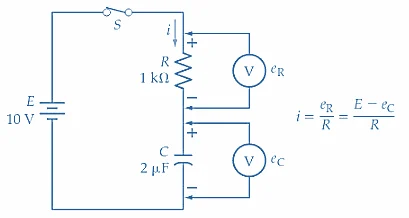 (a) Simple resistor-capacitor circuit
The capacitor voltage in a series CR circuit tends to grow slowly from zero
to its final level when the supply voltage is first switched on. Image used
courtesy of EETech
(a) Simple resistor-capacitor circuit
The capacitor voltage in a series CR circuit tends to grow slowly from zero
to its final level when the supply voltage is first switched on. Image used
courtesy of EETech
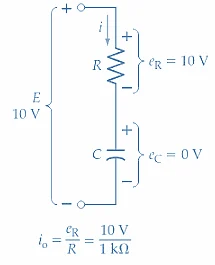 (b) Voltages at t = 0
(b) Voltages at t = 0
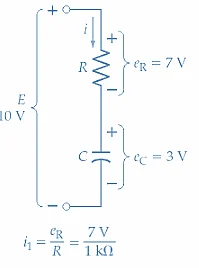 (c) Voltages at t = t1
(c) Voltages at t = t1
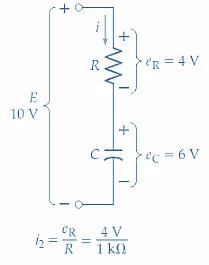 (d) Voltages at t = t2
Figure 1. The capacitor voltage in a series CR circuit tends to grow slowly
from zero to its final level when the supply voltage is first switched on.
Image used courtesy of EETech
The current flow causes the capacitor to charge with the polarity illustrated.
After a time t1, the capacitor voltage might be 3 V [see Figure 1(c)]. Then the
charging current becomes
I = (10V - 3V) / 1K = 7Ma
It is seen that because C has accumulated some charge, the voltage across R is
reduced, and consequently, the charging current is reduced from 10 mA to 7 mA.
Because the charging current has been reduced, the capacitor voltage is now
growing at a slower rate than before. The instantaneous levels of eC at t = 0
and t = t1 can now be plotted on the graph of eC versus time; points 1 and 2 in
Figure 2.
After time t2, the capacitor voltage has grown to 6 V [Figure 1(d)]. The
charging current now becomes
I = (10V - 6V) / 1K = 4 Ma
The charging current has been further reduced (from 7 mA to 4 mA), so the
capacitor is charging at an even slower rate than before. Because the charging
current has been decreasing, the time for the capacitor to charge from 3V to 6V
is longer than the time for it to charge from 0 V to 3 V. Point 3 is plotted
at t2 and eC = 6 V in Figure 2.
(d) Voltages at t = t2
Figure 1. The capacitor voltage in a series CR circuit tends to grow slowly
from zero to its final level when the supply voltage is first switched on.
Image used courtesy of EETech
The current flow causes the capacitor to charge with the polarity illustrated.
After a time t1, the capacitor voltage might be 3 V [see Figure 1(c)]. Then the
charging current becomes
I = (10V - 3V) / 1K = 7Ma
It is seen that because C has accumulated some charge, the voltage across R is
reduced, and consequently, the charging current is reduced from 10 mA to 7 mA.
Because the charging current has been reduced, the capacitor voltage is now
growing at a slower rate than before. The instantaneous levels of eC at t = 0
and t = t1 can now be plotted on the graph of eC versus time; points 1 and 2 in
Figure 2.
After time t2, the capacitor voltage has grown to 6 V [Figure 1(d)]. The
charging current now becomes
I = (10V - 6V) / 1K = 4 Ma
The charging current has been further reduced (from 7 mA to 4 mA), so the
capacitor is charging at an even slower rate than before. Because the charging
current has been decreasing, the time for the capacitor to charge from 3V to 6V
is longer than the time for it to charge from 0 V to 3 V. Point 3 is plotted
at t2 and eC = 6 V in Figure 2.
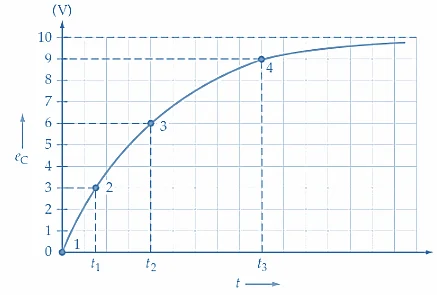 Figure 2. Graph showing the typical growth of capacitor voltage plotted versus
time for a series RC circuit, starting from the instant of supply voltage
switch-on. Image used courtesy of EETech
An even longer time is now required for the capacitor voltage to grow by another
3 V (point 4 in Figure 2). Because eC is continuously increasing, the voltage
across R is continuously decreasing, so the charging current is continuously
decreasing. This means that C is charged at a rapid rate initially, then the
rate decreases as the capacitor voltage grows. As in the case of the RL circuit,
the terms step response and forced response are sometimes used to describe the
RC circuit response to a dc input voltage.
Figure 2. Graph showing the typical growth of capacitor voltage plotted versus
time for a series RC circuit, starting from the instant of supply voltage
switch-on. Image used courtesy of EETech
An even longer time is now required for the capacitor voltage to grow by another
3 V (point 4 in Figure 2). Because eC is continuously increasing, the voltage
across R is continuously decreasing, so the charging current is continuously
decreasing. This means that C is charged at a rapid rate initially, then the
rate decreases as the capacitor voltage grows. As in the case of the RL circuit,
the terms step response and forced response are sometimes used to describe the
RC circuit response to a dc input voltage.
Instantaneous Current and Voltage in RC Circuit
Voltage Equation
The equation for the instantaneous voltage on a capacitor in a
resistive-capacitive circuit can be derived by differential calculus:
Ec = E - (E - Eo) ϵ - t/CR
Where
eC = capacitor voltage at time t
E = supply voltage
Eo = initial level of capacitor voltage
ε = exponential constant = 2.71
t = time, in seconds, from the commencement of the charge
C = capacitance value, in farads
R = charging resistance, in ohms
Using Equation 2, the instantaneous levels of capacitor voltage can be
calculated for several different time intervals from t = 0 for a given circuit.
The corresponding values of eC and t can then be plotted to give an accurate
graph of eC versus t for the circuit. The equation can also be manipulated to
obtain expressions for t, C, and R for a given capacitor voltage level. When the
capacitor is initially uncharged
E0 = 0 Eo=0
And
Ec = E - (Eϵ^(-t/CR) eC=E−(E ϵ −t(CR))
Or
Ec = E (1 - ϵ^-(t/CR) eC=E(1−ϵ−t(CR))
Also, from Equation 2
ϵ^-(t/CR) = (E - Eo) / (E - Ec) ϵt(CR)=E−EoE−eC
Taking the natural logarithm of both sides
t/CR = In(E - E0) / (E - Ec) tCR=In(E−EoE−eC)(4)
Equation 4 can be further simplified if the capacitor starting voltage (Eo) is
assumed to be zero:
t/CR = In( E / (E - Ec)) tCR=In(EE−eC)(5)
Equation 5 can be used to determine t, C, or R when the other quantities are
known.
Example 1
For the circuit in Figure 1(a), calculate the times t1, t2, and t3 for plotting
the capacitor current versus the time graph in Figure 2.
Solution 1
From Equation 5
t = CR x ln(E/(E-Ec) t=CR×ln(EE−eC)
At eC = 3V t1=2μF×1kΩ×ln(10V10V−3V)
T1 = 2Ufd x 1K x ln( 10V/(10V - 3V) = 0.7ms
At eC = 6V t2=2μF×1kΩ×ln(10V10V−6V)
T2 = 2Ufd x 1k x ln( 10V / (10V - 6V) = 1.8Ms
At eC = 9V t3=2μF×1kΩ×ln(10V10V−9V)
T3 = 2Ufd x 1K x ln( 10V / (10V - 9V) = 4.6Ms
Example 2
Determine the instantaneous values of capacitor voltage at 1 ms intervals from
t = 0 for the circuit in Figure 1(a).
Solution 2
Assuming that the initial level of capacitor voltage is zero, Equation 3 can be
used.
Ec = E(1 - ϵ^(-t/CR)) eC=E(1−ϵ−t(CR))
|
|
|
|
| At t = 0 | eC=0 | point 1 in Figure 3
|
| At t =1 ms | Ec = 10V(1 -ϵ^(-1ms/CR) = 3.93V
| point 2
|
| At t = 2 ms | eC≈6.32 V | point 3
|
| At t = 3 ms | eC≈7.77 V | point 4
|
| At t = 4 ms | eC=8.65 V | point 5
|
| At t = 5 ms | eC≈9.18 V | point 6
|
| At t = 6 ms | eC≈9.5 V | point 7
|
| At t = 7 ms | eC≈9.7 V | point 8
|
| At t = 8 ms | eC≈9.82 V | point 9
|
| At t = 10 ms | eC≈9.93 V | point 10
|
| At t=∞ | Ec = 10V = Max Voltage Lvl
|
Time Constant
Referring to the graph of eC versus t plotted in Figure 3, it is seen that when
t =2 ms, eC is 6.32 V. Note that 6.32 V is 63.2 percent of the maximum voltage
level (10 V).
Also
t = CR = 2Ufd x 1K = 2Ms t=CR=2μF×1kΩ=2ms
So, when t = CR, the instantaneous capacitor voltage level is always 63.2% of E.
The quantity CR is the time constant ( ) of a resistive-capacitive circuit, and,
as in the case of an RL circuit, the time constant largely determines the
circuit's behavior. After a time period of 5 RC, the capacitor voltage is 99.3%
of its maximum level. By drawing a straight line at a tangent to the graph of
eC / t, it can be shown that if the initial rate of charge were maintained, the
capacitor voltage would reach its maximum level at a time of t =CR (see Figure 3).
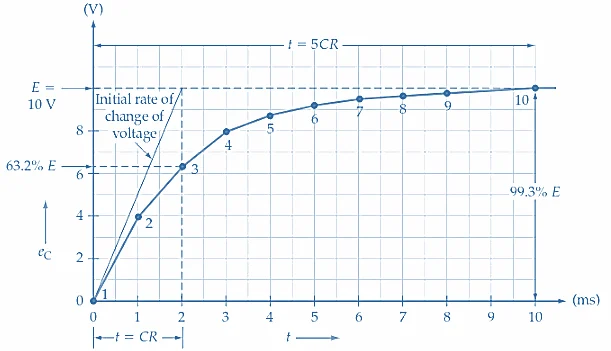 Figure 3. Graph capacitor voltage (eC) versus time (t) for a series CR
circuit. The voltage increases to 63.2% of its maximum level at t = CR and
to 99.3% of its maximum at t = 5CR. Image used courtesy of EETech
Figure 3. Graph capacitor voltage (eC) versus time (t) for a series CR
circuit. The voltage increases to 63.2% of its maximum level at t = CR and
to 99.3% of its maximum at t = 5CR. Image used courtesy of EETech
Charging Current
Equation 3 can be manipulated to determine an equation for the instantaneous
charging current at any time.
Equation 3
Ec = E(1 - ϵ^(-t/CR)) eC=E(1−ϵ−t(CR))
Equation 1
I = (E - Ec) / R i=E−eCR
So,
I = E -E(1 - ϵ^(-t/CR)) i=E−E(1−ϵ−t(CR))R
Giving
I = Ee^(-t/CR) i=Ee−t(CR)R(6)
Alternatively, when the instantaneous capacitor voltages are known, the
corresponding current levels can be determined from Equation 1.
I = (E - Ec) / R i=E−eCR
The graph of iC versus t in Figure 4 shows how the charging current changes with
time. At t = 0, iC = E/R. At t = CR, iC has fallen by 63.2% of E/R. And at
t = 5CR, iC has fallen through 99.3% of its initial level.
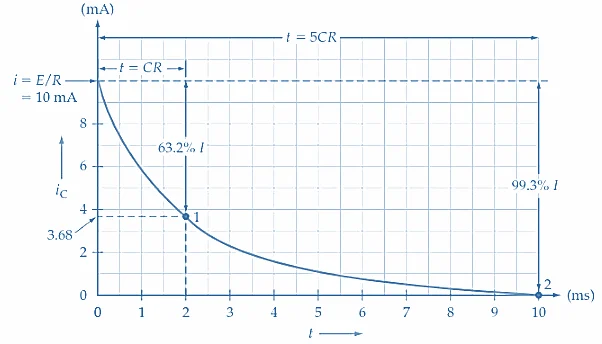 Figure 4. Graph of capacitor charging current (iC) versus time (t) for a series
CR circuit. The current falls by 63.2% of its maximum level at t = CR and by
99.3% of its maximum at t = 5CR. Image used courtesy of EETech
Figure 4. Graph of capacitor charging current (iC) versus time (t) for a series
CR circuit. The current falls by 63.2% of its maximum level at t = CR and by
99.3% of its maximum at t = 5CR. Image used courtesy of EETech
Example 3
Calculate the level of capacitor charging current for the circuit in Figure
1(a) at t =CR and t = 5CR.
Solution 3
At t = CR
I = (Eϵ^(-t/CR)) / R = (10V x ϵ^(-1))/1K = ≈ 3.68Ma point 1 in Fig. 4
At t = 5 CR
I = (10V x ϵ^(-5)) / 1K ≈ 67.Ua point 2 in Fig. 4
Takeaways of RC Circuit Operation
An RC circuit is an electrical circuit with a resistor and a capacitor connected
in series or parallel. It is a fundamental circuit in electronics, and its
behavior is governed by the interaction between the resistor and capacitor.
In an RC circuit, the capacitor stores electrical energy in its electric field
when a voltage is applied, while the resistor limits the current flow through
the circuit. The behavior of an RC circuit is governed by the time constant,
which is the product of the resistance and capacitance values (RC). It
determines how quickly the capacitor charges or discharges in response to a
voltage change.
When a voltage is applied to an RC circuit, the capacitor initially acts as an
open circuit, blocking the current flow. As the capacitor charges up, it begins
to conduct current, and the voltage across the capacitor decreases. Eventually,
the capacitor fully charges, and the current through the circuit stops flowing.
When the voltage source is removed, the capacitor begins to discharge through
the resistor. As the capacitor discharges, the voltage across the capacitor
decreases, and the current through the circuit decreases. Eventually, the
capacitor fully discharges, and the current through the circuit stops flowing.
The RC circuit's time constant is defined as the product of the resistance and
capacitance values (RC), representing the time it takes for the capacitor to
charge or discharge to 63.2% of its maximum voltage. A longer time constant
means a slower charging or discharging process, while a shorter time constant
means a faster charging or discharging process.
Related Content
Learn More About:
 (a) Simple resistor-capacitor circuit
The capacitor voltage in a series CR circuit tends to grow slowly from zero
to its final level when the supply voltage is first switched on. Image used
courtesy of EETech
(a) Simple resistor-capacitor circuit
The capacitor voltage in a series CR circuit tends to grow slowly from zero
to its final level when the supply voltage is first switched on. Image used
courtesy of EETech
 (b) Voltages at t = 0
(b) Voltages at t = 0
 (c) Voltages at t = t1
(c) Voltages at t = t1
 (d) Voltages at t = t2
Figure 1. The capacitor voltage in a series CR circuit tends to grow slowly
from zero to its final level when the supply voltage is first switched on.
Image used courtesy of EETech
The current flow causes the capacitor to charge with the polarity illustrated.
After a time t1, the capacitor voltage might be 3 V [see Figure 1(c)]. Then the
charging current becomes
I = (10V - 3V) / 1K = 7Ma
It is seen that because C has accumulated some charge, the voltage across R is
reduced, and consequently, the charging current is reduced from 10 mA to 7 mA.
Because the charging current has been reduced, the capacitor voltage is now
growing at a slower rate than before. The instantaneous levels of eC at t = 0
and t = t1 can now be plotted on the graph of eC versus time; points 1 and 2 in
Figure 2.
After time t2, the capacitor voltage has grown to 6 V [Figure 1(d)]. The
charging current now becomes
I = (10V - 6V) / 1K = 4 Ma
The charging current has been further reduced (from 7 mA to 4 mA), so the
capacitor is charging at an even slower rate than before. Because the charging
current has been decreasing, the time for the capacitor to charge from 3V to 6V
is longer than the time for it to charge from 0 V to 3 V. Point 3 is plotted
at t2 and eC = 6 V in Figure 2.
(d) Voltages at t = t2
Figure 1. The capacitor voltage in a series CR circuit tends to grow slowly
from zero to its final level when the supply voltage is first switched on.
Image used courtesy of EETech
The current flow causes the capacitor to charge with the polarity illustrated.
After a time t1, the capacitor voltage might be 3 V [see Figure 1(c)]. Then the
charging current becomes
I = (10V - 3V) / 1K = 7Ma
It is seen that because C has accumulated some charge, the voltage across R is
reduced, and consequently, the charging current is reduced from 10 mA to 7 mA.
Because the charging current has been reduced, the capacitor voltage is now
growing at a slower rate than before. The instantaneous levels of eC at t = 0
and t = t1 can now be plotted on the graph of eC versus time; points 1 and 2 in
Figure 2.
After time t2, the capacitor voltage has grown to 6 V [Figure 1(d)]. The
charging current now becomes
I = (10V - 6V) / 1K = 4 Ma
The charging current has been further reduced (from 7 mA to 4 mA), so the
capacitor is charging at an even slower rate than before. Because the charging
current has been decreasing, the time for the capacitor to charge from 3V to 6V
is longer than the time for it to charge from 0 V to 3 V. Point 3 is plotted
at t2 and eC = 6 V in Figure 2.
 Figure 2. Graph showing the typical growth of capacitor voltage plotted versus
time for a series RC circuit, starting from the instant of supply voltage
switch-on. Image used courtesy of EETech
An even longer time is now required for the capacitor voltage to grow by another
3 V (point 4 in Figure 2). Because eC is continuously increasing, the voltage
across R is continuously decreasing, so the charging current is continuously
decreasing. This means that C is charged at a rapid rate initially, then the
rate decreases as the capacitor voltage grows. As in the case of the RL circuit,
the terms step response and forced response are sometimes used to describe the
RC circuit response to a dc input voltage.
Figure 2. Graph showing the typical growth of capacitor voltage plotted versus
time for a series RC circuit, starting from the instant of supply voltage
switch-on. Image used courtesy of EETech
An even longer time is now required for the capacitor voltage to grow by another
3 V (point 4 in Figure 2). Because eC is continuously increasing, the voltage
across R is continuously decreasing, so the charging current is continuously
decreasing. This means that C is charged at a rapid rate initially, then the
rate decreases as the capacitor voltage grows. As in the case of the RL circuit,
the terms step response and forced response are sometimes used to describe the
RC circuit response to a dc input voltage.
 Figure 3. Graph capacitor voltage (eC) versus time (t) for a series CR
circuit. The voltage increases to 63.2% of its maximum level at t = CR and
to 99.3% of its maximum at t = 5CR. Image used courtesy of EETech
Figure 3. Graph capacitor voltage (eC) versus time (t) for a series CR
circuit. The voltage increases to 63.2% of its maximum level at t = CR and
to 99.3% of its maximum at t = 5CR. Image used courtesy of EETech
 Figure 4. Graph of capacitor charging current (iC) versus time (t) for a series
CR circuit. The current falls by 63.2% of its maximum level at t = CR and by
99.3% of its maximum at t = 5CR. Image used courtesy of EETech
Figure 4. Graph of capacitor charging current (iC) versus time (t) for a series
CR circuit. The current falls by 63.2% of its maximum level at t = CR and by
99.3% of its maximum at t = 5CR. Image used courtesy of EETech